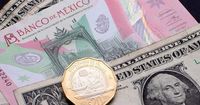On Monday, March 31, 2025, the Mexican peso experienced a notable depreciation against the U.S. dollar, continuing a trend that has raised concerns among investors. The exchange rate was reported at approximately 20.43 pesos per dollar, reflecting a loss of 0.44%, or 9 centavos, for the peso. This downward movement follows a 0.56% depreciation recorded in the previous week, signaling ongoing economic challenges for Mexico.
The exchange rate fluctuated throughout the day, reaching a maximum of 20.4739 and a minimum of 20.3321. As the market opened, the dollar was priced at 20.39 pesos, indicating a slight recovery from the previous week but still presenting a volatile environment. Various banks in Mexico reported their exchange rates, with Banco Afirme buying at 19.40 pesos and selling at 20.90 pesos, while Citibanamex quoted a buying price of 19.68 pesos and a selling price of 20.88 pesos.
Financial analysts are closely monitoring the situation, particularly due to the upcoming tariffs that the U.S. is set to impose on April 2, 2025. Janneth Quiroz Zamora, director of analysis at Grupo Financiero Monex, indicated that the peso's current losses are linked to market caution surrounding these tariffs, which are expected to affect various countries, including Mexico. The uncertainty surrounding these measures has led to a nervous atmosphere in the financial markets.
In a broader context, the peso has shown some resilience despite recent pressures. Earlier in March, the peso had recorded gains, closing at 20.40 pesos on March 28, but the looming tariffs have cast a shadow over its performance. The Mexican currency had previously shown stability, recovering from a dip earlier in the month, but the recent developments signal a potential shift in that trend.
As of Monday morning, the peso registered a slight gain of 0.17% against the dollar, with an interbank rate of 20.34 pesos per unit. This uptick, however, comes amid a backdrop of uncertainty, as the U.S. administration's plans to impose tariffs on automotive imports could significantly impact Mexico's economy. President Donald Trump has confirmed that tariffs will be applied to automobiles not manufactured in the U.S., further complicating the economic landscape.
The current exchange rate reflects the ongoing volatility of the peso, with analysts predicting a range of 20.30 to 20.45 pesos for the dollar throughout the week. The Dollar Index (DXY), which measures the value of the dollar against a basket of currencies, has also shown fluctuations, rising by 0.17% today. This indicates that the dollar is gaining strength globally, which could further pressure the peso.
In the wake of these economic developments, the Mexican peso's performance is being closely watched. The peso's depreciation comes at a time when the country is grappling with external economic pressures and internal challenges. The uncertainty surrounding the U.S. tariffs is expected to influence the peso's value in the coming days.
Despite the current challenges, some analysts remain cautiously optimistic about the peso's potential for recovery. UBS has projected that the peso could stabilize around the 20 pesos mark by the end of the year, contingent on the outcomes of ongoing negotiations and the broader economic landscape. This sentiment reflects a belief that Mexico and the U.S. may reach agreements that could mitigate the impact of the proposed tariffs.
As the financial community prepares for what has been dubbed 'Liberation Day' on April 2, the atmosphere remains tense. Investors are keenly aware that the decisions made in the coming days could have lasting implications for the Mexican economy. The outcome of discussions between Mexican Secretary of Economy Marcelo Ebrard and U.S. officials will be pivotal in shaping the future of trade relations between the two countries.
The Mexican peso's trajectory is not only influenced by U.S. tariffs but also by broader economic indicators, including inflation data from the U.S., which are expected to be released soon. Analysts at Actinver have cautioned that the strength of the peso will depend significantly on the monetary policy of the Bank of Mexico (Banxico) and the evolving trade dynamics with the U.S.
In conclusion, the Mexican peso's performance against the dollar is a reflection of complex interdependencies between domestic economic conditions and international trade relations. As the country braces for the imposition of tariffs, the financial markets remain vigilant, awaiting clarity on the economic policies that will shape the future.









